
(Including how not to get flies out of a day and night blind, and advice on getting insects out of day and night blinds that are very wide.)
Getting flies out of day and night blinds (or mosquitos, wasps, moths, and various other flying things that most of us don’t know the proper names for) is only likely to be a problem for about two to four weeks of the year.
These are the two to four weeks of the year when the weather is so epically hot that we spend most of the day with our windows wide open whilst simultaneously, all things that fly, buzz, and potentially bite are enjoying a seasonal population explosion and decide that your place looks like an excellent venue within which to conduct their business.
This means that you’re potentially going to find that flies and other flying insects might get trapped in or on your day and night blind and be unable to free themselves and buzz off, leaving you to find a way to encourage them to vacate; most likely at the conclusion of their lifecycle, because they often prove unable to do this under their own steam.
Removing flies trapped in a day and night blind (or caught up in the fabric of the blind) isn’t difficult, but you do need to be careful about the approach you choose because day and night blind fabrics are quite delicate and may become damaged if you go at things a little harder than is needed.
With this in mind, I spent several hours Downstairs (technically, I am paid for work performed Upstairs here at Blinds Towers) with a few of the folk who work in the fabrication and R&D departments, where we tried out a number of approaches to getting insects out of day and night blinds to see what worked most effectively and with the least hassle, all without damaging the blind in the process.
The result of our labour is this comprehensive guide on how to get insects out of day and night blinds in various different ways, plus a couple of specific examples of things not to do, and a reasonably thorough explanation of why and how insects or flies may get trapped in day and night blinds in the first place.
Contents
- 1. How come insects and flies get trapped in day and night blinds in the first place?
- 2. Why is getting insects out of day and night blinds a potential challenge?
- 3. How to get flies out or day and night blinds without damaging the blind.
-
4. How to get insects out of day and night blinds without taking it down.
- i. The (safe) hairdryer approach to getting dead flies out of day and night blinds.
- ii. The compressed air duster approach to getting insects out of day and night blinds.
- iii. The long-handled duster approach to removing flies from day and night blinds.
- iv. The (safe) vacuum cleaner approach to getting dead insects out of day and night blinds.
- 5. How do you remove flies stuck inside day and night blinds if the blind is very wide?
- 6. How do you get dead flies off day and night blinds if they’re hanging from the fabric?
- 7. How do you get rid of flies on day and night blinds if they’re still alive and buzzing about?
- 8. Can you prevent or discourage flies from getting stuck in day and night blinds?
- 9. Things not to do to get flies out of a day and night blind.
- 10. And finally… This final section can safely be skipped, unless you’re specifically interested in learning how I managed to experiment with getting flies out of day and night blinds in the first place, given that flies don’t tend to be easy to train and don’t respond well to “GET IN THE BLIND SO THAT I CAN GET YOU BACK OUT OF IT, WILL YOU!”-style instructions.
1. How come insects and flies get trapped in day and night blinds anyway?
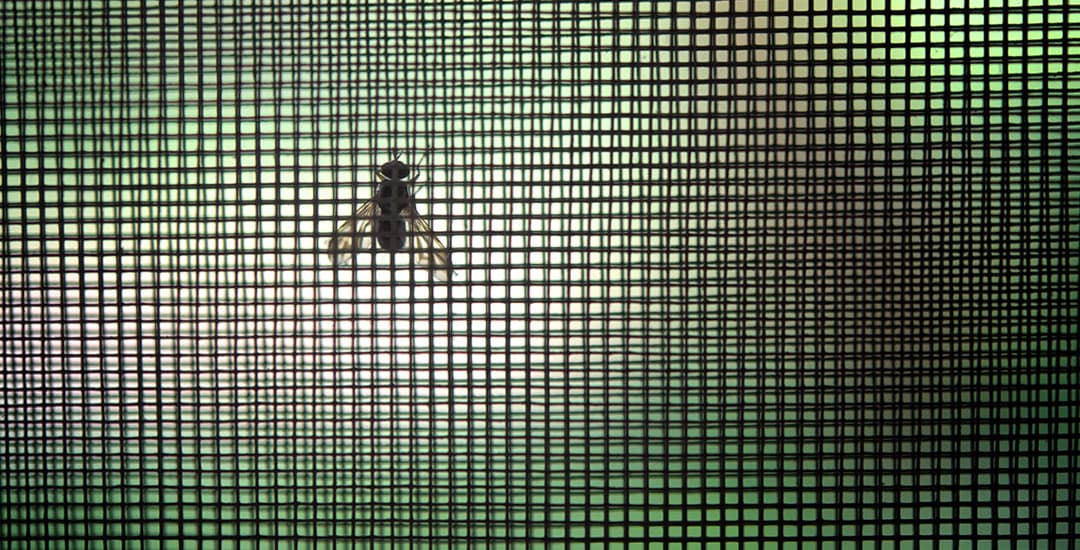
Day and night blinds are fairly unique in terms of their construction and function, as they’re the only type of window blind that consists of a continuous loop of fabric that passes around tubes at the top and bottom, with a small gap between the front and back of the fabric forming a void of a couple of cm in the middle.
Both the construction of day and night blinds in terms of the loop/void that they form, plus the materials used to make them, lend themselves rather well to trapping flies and insects when said creatures are out in force.
Now, the fact that there’s only a narrow void of space between the front piece of fabric and the back one means that it’s reasonably hard or unlikely that insects/flies will wander into said void in the first place, But as anyone who has ever tried to shoo a fly, wasp, moth, or similar out of an enormous open window or door will know, said insects are nothing if not incredibly stupid and reluctant to follow clear signage to the exit if they do manage to find a point of entry in the first place.
The fact that said void is also narrow and ergo, the exits from it are small compared to a vast swathe of fabric that your bugs (yes they’re yours now, possession is 9/10ths of the law) cannot escape through also means that if and when they do fly or crawl in between the front and back of the blind, they’re probably going to remain in there until you either free them, or they eventually die of stupidity/exhaustion.
The other way in which flies and other insects get trapped on or in (or both) day and night blinds is due to the construction of the sheer or voile parts of the blind’s fabric. These are made of a fine meshy material, which depending on the insect in question, might be of just the right level of density and coarse adhesiveness to function as a tiny gin trap equivalent to snare a tiny leg.
Whilst most flying irritants have several legs to spare should this happen to them, they also seem unreasonably reluctant to part themselves from said leg in the name of achieving freedom.
This ultimately means that whilst most of your day and night blinds fly and insect-related catches will tend to be the hard-of-thinking that fly or climb between the fabric layers and can’t get out for no reason other than a poor sense of direction, others might end up trapped due to becoming caught up in the mesh and unable to free themselves.
Either way, one or both of these scenarios occurring will cause your day and night blind to trap certain flies/insects, and prevent them from bothering you in the room or house at large, which on the one hand, may mean that your day and night blind also serves the dual purpose of functioning as a massive flytrap, yay!
The downside of this is of course that it may mean that your day and night blind functions as a massive flytrap, boo!
Still, whether you’re a glass half full or glass half empty type when it comes to the pros and cons of having a blind that traps flies, you’re probably not a “love having a blind harbouring dead and half-dead flies and bugs” kind of person too.
Ultimately then, whether you’re dealing with flies, mosquitos, moths, wasps, daddy longlegs-s (if anyone can tell me definitively what the plural of daddy longlegs is, I am all ears), or anything else similar setting up residence in your blind, and whether said collective of bugs is alive, dead, or a combination of both, and trapped between the void or hanging onto the fabric…
…I’m going to take a wild guess and suggest that you’d probably prefer that they weren’t on/in the blind at all (particularly if your judge-y in-laws are coming over), and that you might want to remove them.
Herein lies the potential challenge, which I will elucidate upon in section two:
2. Why is getting flies out of day and night blinds a potential challenge?
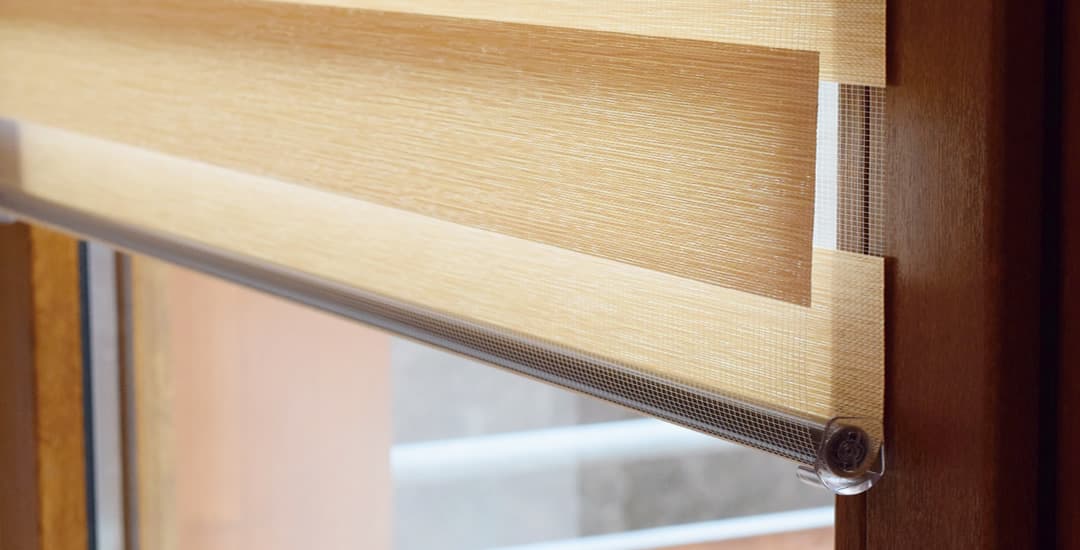
Getting insects out of day and night blinds isn’t actually hard, fiddly, or time consuming, but it does need to be undertaken in such a way as to avoid damaging the blind in the process.
If your day and night blind is also reasonably wide, you might face an issue in that the insects stuck in or near the middle of the blind are out of arm’s reach or the reach of some of the implements you might be thinking of using to evict them.
Also, the void or gap between the front and back of the blind’s fabric is very narrow (a couple of centimetres) which means that you’re limited in terms of the sort of space you have to work with within the blind.
These things mean that you may need to use a certain tool or appliance to get flies out of day and night blinds (and I’ll cover these as we go along), although there’s a good chance you already have them at home, and if you don’t, there are other options too.
The additional challenge then as well as access, is removing insects from day and night blinds without tearing, warping, or otherwise damaging the fabric of the blind itself. This is a potential issue to be very mindful of, because the sheer or voile stripes of the blind are not only potentially excellent at trapping insect legs, but are also quite fine and delicate too.
This means that the sort of go-to approaches that myself and others keen to use a sledgehammer to crack a walnut are apt to take are probably going to be total overkill, and also likely blinds-kill as well. I speak from a place of some experience here, as I tried all of them out as part of the practical side of this project on determining how to get insects out of day and night blinds without ruining the blind in the process.
So, moving on then…
3. How to get flies out of day and night blinds without damaging the blind
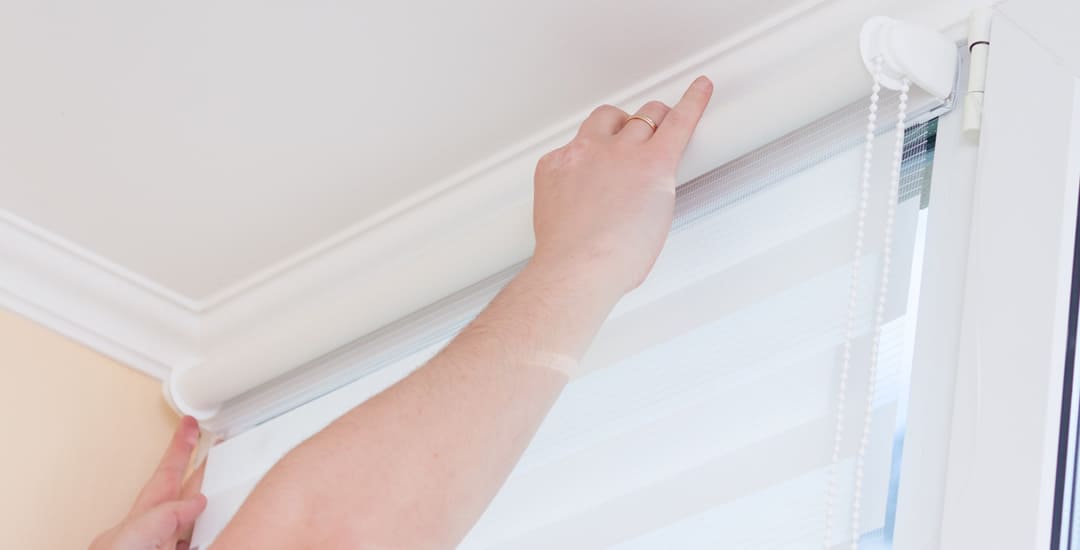
If your blind is small-ish, and you’re in a hurry and/or don’t have or can’t be doing with hunting out any of the various implements/tools I’m going to talk about later to help to get insects out of your day and night blind, you could potentially just take the blind down.
Roll the blind down to its full length, take the bottom bar out, remove the blind itself from its brackets, and shake it out to release any trapped insects and other debris.
However, this approach won’t work (or will be too unwieldy to undertake on your own) if your blind is wide or generally large, and may have only limited effectiveness when it comes to freeing up insects caught on the fabric itself. You do also need to handle the fabric of the blind with care and ensure you don’t bash it too hard, nor snag or catch it on anything else on or around the window.
4. How to get insects out of day and night blinds without taking the blind down

Getting down to the more maverick/experimental part of my trials on the best way to get insects out of day and night blinds, I have identified four different ways to remove dead bugs lying in the bottom of the blind while the blind is still in situ, without the need to remove the blind from the wall.
All of them work, and if you follow them exactly, are safe for the blind; however, some of them might be somewhat unpalatable to your sensibilities, for reasons that I will explain if relevant as we go along.
For all of them, I suggest that you start by having the blind rolled down to the full extent of its drop once more, and if the blind is much wider than the length of your arm, having a minion help you by holding the fabric out from the void to allow you more room to manoeuvre.
Here are your four options for safely getting insects out of the bottom of day and night blinds without taking the blind down:
i. The hairdryer approach to getting dead flies out of day and night blinds (effective but potentially gross)
If all you heard here was “get a hairdryer and blast,” I beseech you to stop and read the next line carefully, lest you inadvertently cause the untimely demise of your day and night blind due to going off half-cocked:
SAID HAIRDRYER MUST, I MEAN MUST, BE BLOWING OUT COOL AIR, which means that if your hairdryer does not have a “cool shot” button, it will not be suitable. This is because high levels of heat can cause the synthetic fabric of your day and night blind to soften or even literally melt, causing localised warping that will ruin the cosmetic appearance and potentially, smooth functioning of your blind.
Thank you for listening. So, how do you safely get flies out of a day and night blind with a hairdryer? Ensure that the air coming out of the hairdryer is cool, then hold the fabric out from the void (you can remove the blind’s bottom bar to do this if you want to, although it may not be necessary) and use the hairdryer to blow the assorted detritus of bodies out of the other side of the blind.
The downside of this/why it’s potentially gross and you might not want to do it is that it will, as mentioned, blow the assorted detritus of bodies clean out of the other side of the blind.
Depending on the level of power involved in this and the number of bodies you’re blasting, this might result in an effect similar to setting off a glitter bomb, only you know, comprised of dead bugs that are apt to shower everything (and everyone) within range and result in a nasty clean-up operation and the potential to still be picking the occasional dead fly out of the carpet for some weeks to come.
So, using a hairdryer (on a cool setting) to blow flies or bugs out of a day and night blind definitely works, but you might wish it didn’t.
ii. The compressed air duster approach to getting insects out of day and night blinds (potentially effective, potentially gross)
Compressed air dusters are basically pressurised aerosols that blow a concentrated stream of air from their nozzles, and they’re most widely used for or marketed with the intention of cleaning dust out of fiddly or delicate places such as between the keys of computer keyboards, or the innards of printers.
I am sure, however, that when I tell the manufacturers that they can also be used to shoot dead flies out of the side of a window blind, they’ll be keen to add this to their marketing collateral as well.
So, how well does using a compressed air duster to get insects out of day and night blinds work, is it safe for the blind, and is it any type of gross?
Moderately, probably, and kind of.
A shot of compressed air will definitely move those lightweight dead flies/bugs on down the bus, but the length of the nozzle on a can might not be sufficient to get all the way along a wide day and night blind. You might also run out of air at some point.
The air pressure of these cans isn’t what one would generally consider capable of damaging delicates, otherwise most of us would be somewhat lairy of using them on our expensive tech; but by the same token, a strong blast up close from a concentrator nozzle might in theory damage delicate voile, so proceed with caution and don’t aim the spray right at the fabric.
The gross part? Well, if you do find that using compressed air to blow flies/insects out of a day and night blind does work effectively, you’re going to find yourself in the same boat as with the hairdryer approach, being that dead bug confetti is going to come firing out of the other end of the blind, potentially with some force.
iii. The handled duster approach to removing flies from day and night blinds (4/10 on the grossness scale)
Feather or microfibre dusters with a handle can also be used to get dead bugs out of the centre of day and night blinds, assuming that the stick/pole is long enough to reach from one side of the blind to the other.
Assuming that you move with care and use the duster to push along the length of the blind’s bar rather than inadvertently stabbing at the blind’s fabric, this is a safe and effective way to get flies out of a day and night blind.
You don’t get the same high-powered propulsion scattergun of bugs that you potentially would with a hairdryer or compressed air duster either; although I do advise sticking a bucket under the opposite end of the blind to catch your winnings.
iv. The “vacuum cleaner on mute” approach to getting dead insects out of day and night blinds (3.5/10 on the grossness scale)
STOP! Do not grab your vacuum cleaner and stick the nozzle into the void of your blind and start sucking. You will, I mean will, damage the fabric of the blind, and possibly make it dirty too, not that this is likely to be a huge concern if the blind is now torn or warped.
However, IF you have a vacuum cleaner with a half power/low power mode and you place a piece of moderately thick fabric over the end of the hose or nozzle attachment and secure this in place with an elastic band, you will likely find this quite effective at picking up your dead ‘uns from the inside of the blind and holding them in place on this fabric surface while you get them out of the blind and dispose of them.
If you do have the right type of vacuum cleaner to enable this (and really, I repeat, don’t have a go with a high-powered vacuum, one that still really sucks on a tested piece of fabric even when you’ve covered the end) this might well be the easiest and least-gross way to get dead bugs out of the bottom of the blind.
Also, just to clarify, my low grossness score for the latter two approaches to removing dead flies from a day and night blind is relative to the former two; this is never going to be a particularly fun game, nor something you will necessarily want to undertake before eating.
5. How do you remove flies stuck inside day and night blinds if the blind is very wide?
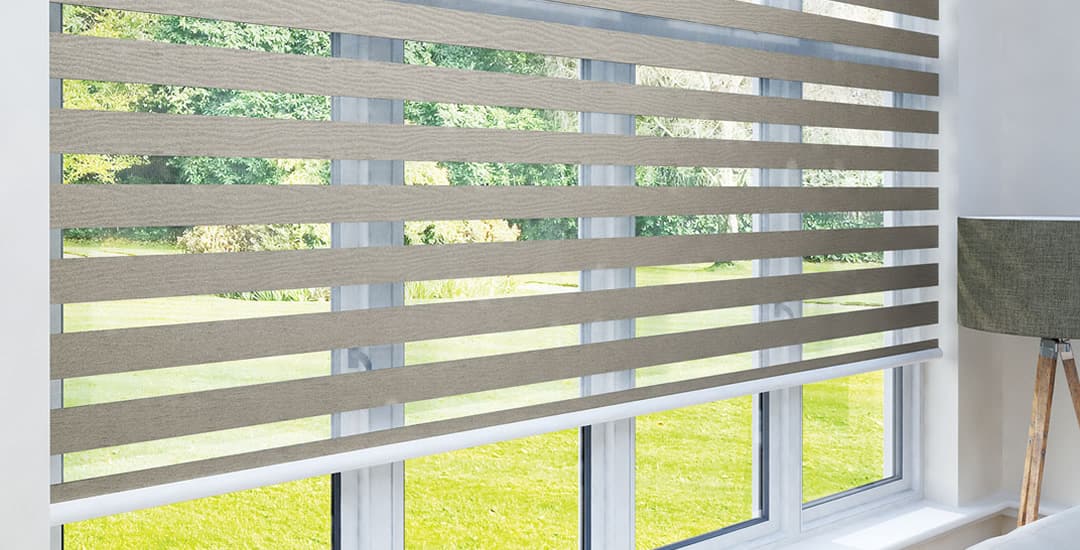
If your day and night blind is particularly wide, this can make things more challenging because the reach of your arm and any implement you’re using as a removal tool might not stretch all the way from one side of the blind to the other.
Given that the aim of the game is to remove dead insects from the bottom of the blind as opposed to working from both ends to push them into a somewhat neater but still objectionable pile in the centre of it, in most cases this is not a situation where you can resolve the issue by going at it from each end in turn.
To get dead flies out of a day and night blind that’s wider than your arm plus the reach of your tool is long, I suggest firstly getting someone to help you, because they can then hold the blind’s fabric out to give you more room to work with, and to leave both of your hands free to begin your new career as an apprentice bug-herder.
There are a few approaches that can do this for you, depending on your preferences and what you have to hand.
You can’t generally make a hairdryer longer or have a further reach than its nozzle allows for – but using a concentrator nozzle might provide a little more oomph to help the air it blows out reach a little closer to the other end of the blind. The same applies for a compressed air duster, and you can sometimes get extra-long nozzles for these, which again, might help.
If either of these approaches help to get your bug collection almost to the other side of the blind if albeit not out of it entirely, you may then be able to go in at that end with a duster on a handle and sweep said bugs out towards you, rather than away from you.
Speaking of dusters with handles, another approach is to use a microfibre or feather duster with a particularly long handle – or what I like to call a Blue Peter handle, in which you use a mop/broom handle and some duct tape (or a similar product with less kidnap-y connotations) to attach the duster’s stick to the longer pole, and then just proceed according to point iii above.
Finally, much as is the case for hairdryers, vacuum cleaner hoses might not reach all the way to the other side of your blind if it’s really wide, but have a quick dig through the attachments it probably came with and see if any combination of them can be used to extend the hose to reach the centre of the blind.
If so, attach your piece of fabric over the nozzle as described above, and go flycatching from one side of the blind into the centre, and then from the other.
6. How do you get dead flies off day and night blinds if they’re hanging from the fabric?
The voile/net/mesh sheer fabric stripes of day and night blinds can, in some cases, serve to trap the legs of flies, moths, and all of their friends, so that what you might find happens now and then is that you end up with a dead’un hanging from the fabric of the blind but not in the bottom of it where they can be swept out along with their mates.
You may well be able to use a microfibre or feather duster to knock them down, or if not, then giving them a tap or flick with your finger should do the trick, and if they’re inside of the blind, they can then be removed using the suggestions above in the normal manner.
Please, please do not be tempted to wave the vacuum cleaner hose at them, even if you happen to be passing – this will almost certainly suck some of that delicate sheer fabric into the hose and damage it.
7. How do you get rid of flies on day and night blinds if they’re still alive and buzzing about?
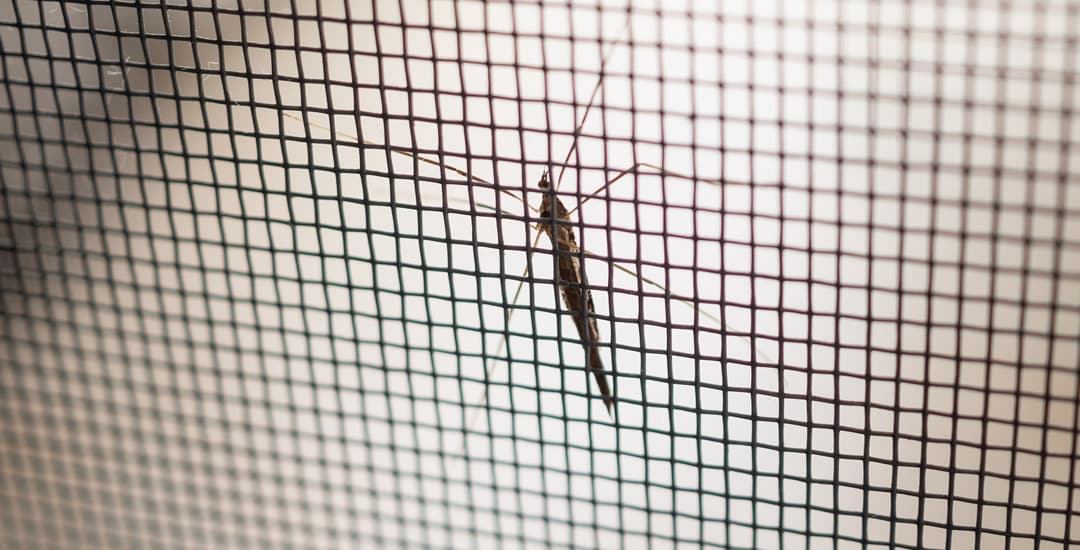
All of the scenarios and remedies that I have outlined thus far are based on the assumption that any flies or insects in your day and night blind are already deceased, generally having died of the level of stupidity that involves flying into something without first checking to see where the exits are.
However, in the stage between your insects flying into/getting caught on the blind and you sweeping their lifeless bodies away, falls an interim stage that I have named from experience as The Annoyance.
Flies, wasps, gnats, or similar flitting around inside of the blind or attempting to disentangle themselves from its fabric are not only going to be a theoretical annoyance (nobody needs this kind of décor really, do they) but an audible one too, due to all of the BBBZZZZZZZZZZZZZZZZZZZZZZZZZZZZZZZZZZZZZZZZ nonsense they’re going to be pulling whilst waiting to succumb to their injuries.
Also, as anyone who ever tried to usher a fly/wasp/moth or whatever out of an enormous open window or door will know only too well, insects are as stupid as all get-out when it comes to not being able to get out via an absolute gift of an exit, and would instead rather throw themselves at glass/lights/yourself until they suffer from what news anchors these days seem to refer to as “lifechanging injuries,” or worse.
This means that there’s such a low chance of any fly or other insect flavour that makes its way into the middle of a day and night blind being able to get out again of their own volition, that if you manage to witness such an event and catch it on video, I will be happy to gift to you a free blind of your choosing.
So, how do you get rid of flies in a day and night blind if they’re still alive and buzzing? The collective fruits of our brainstorming here at Blinds Towers while experimenting with blinds are as follows:
Set them free; by flicking them off the blind if they’re caught in it, or by gently pulling the fabric of the blind outwards to provide a lager exit portal. Factoring in what I mentioned above about the seeming reluctance of flying insects to accept help when brain damage is also on the table, this may take some time.
Also, this latter approach will then leave you with whatever your winged irritant is wandering freely around your home, possibly just providing them with further opportunities to buzz at you in other rooms; and if the insect in question is a wasp or something else stingy/bite-y, they might show their appreciation for your efforts in the traditional fashion, because wasps really are the absolute assholes of the insect kingdom.
Coming at things from something of a different angle, I have another idea on how to get flies out of day and night blinds if they’re alive, and this is simply to wait for them to die of natural causes and then dispose of them in accordance with section four. Maybe turn the radio up a little to drown them out in the interim?
If you want to speed the process along somewhat, you could use a fly spray or other insect killing device and spray them, or the blind as a whole; keeping the spray a reasonable distance back from the blind rather than aimed at any trapped insects at close range, as you might damage the blind with a concentrated spray of liquid.
Also, moths and butterflies tend to shed some kind of weird dusty substance when squashed, touched, or if they fly into things hard (aside, if anyone can tell me what this is or what its purpose is, I’m interested) and aiming at a moth directly on the blind might result in them leaving this residue on the blind’s fabric.
You could, in theory, swat the bug using a swatter/slipper or whatever instead, but I advise against this because once more, it’s going to result in the remains getting smeared on your blind.
8. Can you prevent or discourage flies from getting stuck in day and night blinds?

Day and night blinds are really the only type of blind that can trap flies and insects; but for me, that’s not a good enough reason to discount getting day and night blinds, because this does realistically only tend to happen once or twice over the hottest weeks of the year.
So, aside from switching out for a different type of blind, is there anything you can do to stop flies from getting stuck in day and night blinds in the first place?
Not with anything like 100% reliability, but there are a few things that you can do to reduce the odds of insects climbing or flying into your blind, some pertaining to the blind directly and some of which are more generally designed to keep buzzy things out of your home/on the other side of the windows.
Now, I’m going to assume that most folk would consider keeping their home and particularly, windows hermetically sealed to prevent bugs from getting to the blind as somewhat overkill, so I’m going to bypass that idea.
However, using fly papers/catchers on the window itself, or between the window and the blind for blinds hung outside of the recess might help. If you do have your windows open a lot and particularly if they’re larger windows, hanging nets or fitting mesh inserts into the gaps can allow you to get some air without getting some bugs as well.
Using citronella oils, sprays, and plants around the windows may discourage bugs too.
Something that I think might work as well but that I only found out accidentally after lightly misting my own blind with an insect repellent to kill off a fly it was harbouring, is that this seemed to deter said fly’s friends from coming to his wake for a good week or more afterwards.
So using a fly repellent/killer spray and lightly misting the blind from a reasonable distance back so the only vapour rather than liquid perfuses the blind could well help too.
Finally, if it’s moths that cause you the main drama, this is almost certainly happening because you have your window open, blind down, and a light on inside when it gets dark. I strongly suggest rethinking this, unless you do in fact like my very early suggestion of viewing your day and night blind as a bug trap and considering this a good thing, in which case, knock yourself out.
9. Things not to do to get flies out of a day and night blind

In case you were wondering; here are the things you should not do to get insects off a day and night blind, just in case you were starting to get think-y and didn’t like my earlier suggestions.
- Don’t use a vacuum cleaner to get flies off a day and night blind other than as I outlined earlier on. A vacuum cleaner that’s at normal power or particularly, modern ones designed to pick up pet hair and potentially even small pets (lookin’ at you, Dyson) will quickly suck up the blind’s fabric and almost certainly rip it.
- Don’t be tempted to use a small brush attachment on your vacuum to try and sweep your bugs out of the blind either, as the bristles, however soft they seem, will likely snag the fabric of the blind’s sheer stripes.
- On which note, don’t use any other type of brush to sweep flies out of a day and night blind either, for the same reason.
- If you’re heading down the hairdryer route I mentioned earlier to get insects out of your day and night blind, do be sure it’s on a cool setting. High levels of heat such as the warmth that a normal, everyday hairdryer produces (and particularly, inferno-level heat such as can be achieved with, once more, Dyson’s offerings) will soften and warp the blind’s fabric.
- And finally… I am only mentioning this because one of the R&D lads suggested we try it and to my surprise/disgust, a couple of the others nodded along encouragingly – do not use a water spray bottle/gun, nor obviously a water pistol to try and blast or wash insects out of a day and night blind. Day and night blinds are not waterproof, nor are they good for target practice.
10. And finally… Where did you get your flies?
This is a fair question, because if you think about it (and particularly, if you have experienced it at home) insects don’t tend to get stuck in day and night blinds in the sort of numbers that would make using live prey for the purposes of this guide’s experimentation viable.
So, how did I get flies/emulate insects in day and night blinds in order to determine how best to evict them?
Well, first up I have genuinely had the opportunity to have a crack at this in the field, as I have four day and night blinds at home and am not good about following my own advice on not keeping the windows behind them wide open when it gets dark.
The flicking or brushing them off the fabric thing, and the spraying them with bug spray thing, are all activities I have undertaken at home. The “pushing them out of the blind with a microfibre duster” thing came up at some point too.
When we actually set up trials in Blinds Towers to see what would get flies out of day and night blinds with the intention of ensuring that we didn’t damage the blind, we emulated flies/insects using bits of scrunched up masking tape and paper, plus (because someone wanted an excuse to not eat the healthy lunch their wife prepared and instead, get a Bounty from the food truck) a light scattering of raisins too.
The things you learn…




